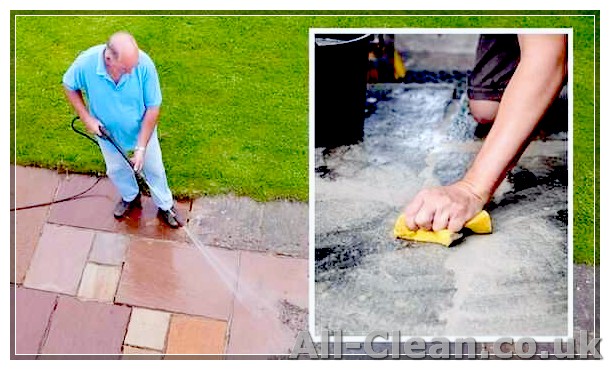
Block paving is a popular choice for driveways, patios, and pathways due to its durability and aesthetic appeal. However, over time, block paving can accumulate dirt, moss, algae, and weeds, which can make it look worn and poorly maintained. While pressure washing is often considered the go-to method for cleaning block paving, it is not the only solution. In fact, pressure washing can sometimes cause damage to the paving slabs and lead to the loss of joint sand. So, if you’re looking for gentler methods to clean your block paving, then read on!
One of the simplest and most effective methods for cleaning block paving is by using soapy water and a scrubbing brush. Begin by sweeping the paving to remove any loose debris. Then, mix a solution of warm water and a mild detergent or washing-up liquid. Apply the soapy water to the paving and use a washing-up brush to scrub away the dirt and stains. Rinse the surface with clean water and repeat the process until the block paving is clean. This method is suitable for general cleaning and can help to remove light stains and dirt.
If your block paving has stubborn stains, such as oil or grease, then you may need to take a different approach. One effective method is to use vinegar. Mix equal parts vinegar and water and apply the solution to the stained areas. Allow the vinegar to sit for a few minutes to penetrate the stains, then scrub the area with a brush. Rinse the surface with clean water and repeat the process if necessary. Vinegar is a natural cleaning agent that can help to break down grease and oil stains without damaging the paving.
In addition to cleaning, it’s important to take care of your block paving to prolong its life and keep it looking its best. Regular aftercare is essential to prevent the growth of weeds, moss, and lichens between the paving blocks. This can be done by sweeping the area regularly to remove leaves and debris, and by applying a weed killer to prevent weed growth. It’s also recommended to reapply joint sand to the paving joints every 6 to 12 months to maintain stability and prevent weed infestation.
So, if you’re looking for effective methods to clean your block paving without a pressure washer, there are plenty of options to choose from. Whether you opt for soapy water and a scrubbing brush or vinegar for stubborn stains, taking the time to clean and maintain your block paving will ensure that it looks great for years to come. Just remember to wear gloves, use appropriate cleaning solutions, and rinse the surface thoroughly after cleaning. With the right approach, your block paving will be back to its original glory in no time!
- Efficient Ways to Clean Block Paving
- Introduction
- Method 1: Basic Cleaning
- Method 2: Using a Block Paving Cleaner
- Method 3: Pressure Washer Alternative
- Method 4: Removing Oil and Grease Stains
- Method 5: Dealing with Weeds, Moss, and Algae
- Method 6: Regular Aftercare and Maintenance
- Use Natural Cleaning Solutions
- Method 1: Water and Detergent Solution
- Method 2: Vinegar and Water Solution
- Scrub with a Stiff Bristle Brush
- Remove Weeds and Moss
- Apply a Sealer
- Step-by-Step Guide:
- Replace Lost Kiln Dried Joint Sand
Efficient Ways to Clean Block Paving
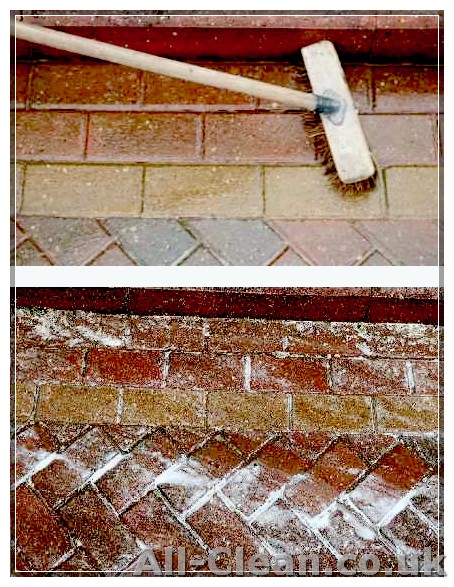
Introduction
If you have block paving on your patio or driveway, it’s important to keep it clean to maintain its appearance and longevity. While pressure washing is a popular method, there are alternative ways to effectively clean block paving without a pressure washer. In this article, we will discuss six efficient methods to clean block paving.
Method 1: Basic Cleaning
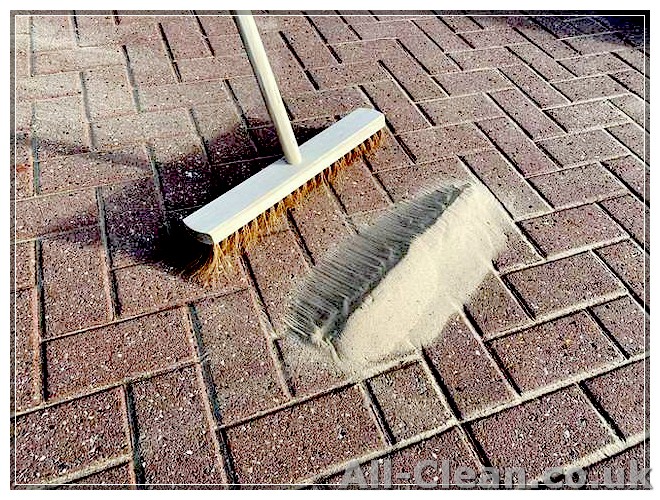
Begin by removing any large pieces of debris or dirt from the surface of the block paving. You can use a brush or broom to gently sweep away the dirt. Then, rinse the area with water to remove any remaining dirt.
Method 2: Using a Block Paving Cleaner
If your block paving is particularly dirty or stained, you may want to use a specialist block paving cleaner. These cleaners are designed to penetrate the layers of dirt and remove stains effectively. Follow the instructions on the cleaner’s packaging and apply it to the dirty areas. After allowing the cleaner to work for a few minutes, use a brush to scrub the surface gently. Rinse the area with water to remove the cleaner and dirt.
Method 3: Pressure Washer Alternative
If you don’t have access to a pressure washer but still want a gentler cleaning method, mix a solution of water and a liquid detergent or soap. Apply the solution to the block paving and use a brush to scrub the surface gently. Rinse the area with water to remove the soap residue and dirt.
Method 4: Removing Oil and Grease Stains
If your block paving has oil or grease stains, you can use a specialist oil and grease remover. Apply the remover to the stained areas and let it sit for the recommended time. Then, use a brush to scrub the stains gently. Rinse the area with water to remove the remover and stains.
Method 5: Dealing with Weeds, Moss, and Algae
If there are weeds, moss, or algae growing between the block paving slabs, you can remove them by hand or with a scraper. Make sure to wear gloves and be careful not to damage the block paving. After removing the growth, apply a weed killer or specialist moss and algae remover to prevent their regrowth.
Method 6: Regular Aftercare and Maintenance
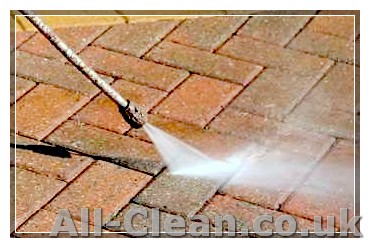
To keep your block paving looking clean and in good condition for longer, regular aftercare and maintenance is essential. Sweep away debris regularly and clean any stains or spills as soon as possible. Apply a protective sealant or kiln-dried sand to the block paving to help prevent weeds and moss from taking root.
Note: Before applying any cleaning or maintenance products, always check the manufacturer’s instructions and recommendations for your specific block paving type.
- If you’re looking for a gentler cleaning method, start with the basic cleaning method using just water and a brush.
- If your block paving is heavily stained or dirty, use a specialist block paving cleaner or a mixture of water and a liquid detergent.
- To remove oil and grease stains, use a specialist remover designed for these types of stains.
- For growths like weeds, moss, or algae, manually remove them and apply a suitable remover or weed killer to prevent their regrowth.
- Regularly maintain your block paving by sweeping away debris and applying aftercare products like sealant or kiln-dried sand.
By following these step-by-step methods, you can effectively clean your block paving without a pressure washer and keep it looking great for months to come!
Use Natural Cleaning Solutions
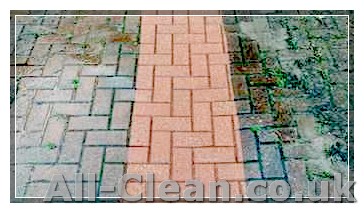
If you prefer a more eco-friendly approach to cleaning your block paving without a pressure washer, you can use natural cleaning solutions. These solutions are not only effective in removing dirt and stains, but they are also safe for the environment.
Method 1: Water and Detergent Solution
One of the most basic and easy methods to clean block paving is using a mixture of warm water and detergent. This solution can help break down and remove dirt, oil, and other stubborn stains.
- Fill a bucket with warm water.
- Add a few drops of mild detergent into the bucket and mix well.
- Start by wetting the block paving with water to loosen any loose dirt or debris.
- Gently scrub the paving slabs with the water and detergent solution using a scrub brush or broom.
- Pay extra attention to any areas with stains or moss.
- After scrubbing, rinse the block paving with clean water.
- Repeat these steps if necessary until the paving is clean.
- Leave the block paving to air dry.
Method 2: Vinegar and Water Solution
If you have stubborn weeds or moss growing between the block paving, a vinegar and water solution can be effective in removing them.
- Mix equal parts of white vinegar and water in a spray bottle.
- Spray the solution directly onto the weeds or moss, making sure to thoroughly wet the area.
- Let the solution sit for 30 minutes to an hour to allow it to penetrate the roots.
- After the waiting time, scrub the affected areas with a brush or broom.
- Rinse the block paving with clean water to remove any remaining vinegar solution.
- Repeat these steps if necessary until the weeds or moss are completely removed.
- For prevention, you can pour sand into the joints between the blocks to discourage weed growth in the future.
By following these natural cleaning solutions, you can effectively clean your block paving without the use of a pressure washer. These methods are less aggressive and will prevent any damage to your paving.
Scrub with a Stiff Bristle Brush
If you’re looking to clean your block paving without a pressure washer, scrubbing with a stiff bristle brush is an effective method. This step-by-step guide will tell you how to remove loose dirt, moss, and weeds from your block paving using just a brush.
- Start by sweeping your patio or paving to remove any loose debris or leaves. This will make it easier to see the areas that need cleaning.
- If you have any large clumps of moss or weeds, it’s a good idea to remove them by hand before starting the cleaning process.
- Fill a bucket with water and add a specialist block paving cleaner or a solution of water and soapy acid. These cleaners are designed to remove stains and algae from paving without causing damage.
- Dip your stiff bristle brush into the cleaning solution and scrub the paving in a circular motion. Pay particular attention to areas with stubborn stains or moss growth.
- For finer details and hard-to-reach spots, you can use an old toothbrush or a smaller brush to get into the joints and gaps between the paving stones.
- Continue scrubbing the entire area until you’ve covered all the paving.
- Once you’re done, rinse the area with clean water to remove any leftover cleaning solution.
- If you still have weeds or moss in the joints, you can use a weed remover or a kiln-dried sand to fill the gaps. This will discourage weed growth and improve the drainage of the paving.
- After cleaning, you may want to consider applying a specialist block paving sealer to protect the surface from future stains and damage.
In conclusion, scrubbing with a stiff bristle brush is an easy and effective way to clean your block paving without a pressure washer. By following these step-by-step instructions and using the right cleaning solution, you can have your paving looking clean and fresh in no time.
Remove Weeds and Moss
If you have block paving, it’s inevitable that you will encounter weeds and moss over time. These unwanted plants can grow in the gaps between the paving stones, making your patio or driveway look unkempt and potentially causing damage to the surface. Fortunately, there are effective methods to remove weeds and moss without using a pressure washer.
1. Basic Manual Method
- Once you spot weeds or moss, use a hard-bristled brush to remove them. Make sure to get rid of any loose debris as well.
- If necessary, scrape out the weeds from the joints using a joint scraper.
- Fill the gaps with kiln-dried sand to discourage weed and moss growth. Sweep the excess sand away.
- Repeat this process every 6 to 7 months to maintain a weed-free and moss-free surface.
2. Vinegar Solution
- If you prefer a chemical-free approach, vinegar can be used as an effective weed and moss killer.
- Mix equal parts of vinegar and water in a spray bottle.
- Apply the solution to the affected areas, making sure to saturate the weeds and moss.
- Leave the solution to work for about 24 hours.
- After 24 hours, use a brush to remove the dead weeds and moss. Rinse the area with water.
3. Commercial Weed Killers
- If you have a severe weed or moss problem, you may consider using a commercial weed killer specifically designed for block paving.
- Follow the instructions on the product label carefully and wear protective gloves.
- Apply the weed killer to the affected areas.
- Allow the weed killer to work according to the instructions.
- Use a brush to remove the dead weeds and moss.
4. Aftercare and Prevention
- After removing the weeds and moss, it’s important to address their root cause. Check for signs of poor drainage or gaps in the block paving that may allow weeds to grow.
- If necessary, replace any damaged or loose blocks to prevent weeds and moss from coming back.
- Regularly sweep and clean the block paving to prevent debris accumulation and weed growth.
Using these methods, you can effectively remove weeds and moss from your block paving without the need for a pressure washer. Choose the method that suits your preference and the severity of the weed and moss problem. With proper maintenance and prevention, you can keep your block paving looking clean and weed-free for years to come.
Apply a Sealer
Applying a sealer to your block paving can help protect it from stains, moss, algae, and other elements. It is a recommended step in the cleaning process, especially if you want your paving to stay clean for a longer time.
Step-by-Step Guide:
- Start by thoroughly cleaning your block paving using one of the methods mentioned above. Make sure that all dirt, stains, moss, and algae are removed.
- After cleaning, allow the paving to dry completely, as applying a sealer on damp surfaces can prevent proper adhesion.
- If there are any spots or stains left on your paving after cleaning, work on removing them using some soapy water and a scrub brush. Scrub the areas gently to avoid damaging the blocks.
- Once the paving is clean and dry, apply the sealer using a pump sprayer or a roller. Make sure to cover all the surfaces evenly, including the joints and any gaps between the blocks.
- Apply a second coat of sealer if needed, following the manufacturer’s instructions. This will provide additional protection and ensure an even coverage.
- Allow the sealer to dry completely before walking or driving on the paved area. This could take anywhere from a few hours to a full day, depending on the type of sealer used.
- After the sealer is dry, perform regular aftercare to keep your block paving in the best condition. This includes sweeping away any debris, removing any spills or stains promptly, and checking for any damage or issues that may need attention.
Applying a sealer to your block paving is a simple and effective method to keep it clean for longer. It helps to prevent stains, moss, and algae growth, making maintenance easier in the long run. Following these step-by-step instructions will ensure that your block paving is well-protected and looks great.
Replace Lost Kiln Dried Joint Sand
If you notice that the kiln dried joint sand in your block paving has been lost or washed away, it is necessary to replace it to maintain the integrity and stability of the block paving surface. Here is a step-by-step guide on how to replace the lost joint sand:
- Before starting, make sure the surface of your block paving is clean. Use a basic cleaning method as listed in the previous section to remove any dirt, weeds, lichens, or spills.
- Once the surface is clean, you can begin replacing the lost joint sand. Make sure you have kiln dried joint sand available for this task.
- Apply a layer of kiln dried joint sand to the block paving surface. You can use a brush or your hands to spread the sand evenly over the joints between the blocks.
- Gently brush the sand into the joints, making sure to fill them completely. You can use a small brush or a special jointing tool for this step. It is recommended to brush diagonally across the joints to ensure thorough coverage.
- After brushing, use a powerful water source, such as a pressure washer on a low setting or a hose with a high-pressure nozzle, to rinse the block paving surface. The water should be directed at a 45-degree angle to the joints to avoid washing away the newly applied sand. Be careful not to apply too much pressure, as it could loosen the sand.
- If there are any remaining gaps or areas where the sand was not properly filled, repeat steps 3-5 until all the joints are filled evenly.
- Once the sand is in place, leave it to dry for at least 24 hours. During this time, avoid any heavy traffic or activities on the block paving surface.
- After the sand is dry, inspect the joints for any signs of unevenness or gaps. If necessary, add more sand and repeat steps 3-5.
- If you are unsure about any of the steps or encounter difficulties while replacing the joint sand, it is best to consult a specialist or call a professional block paving contractor for assistance.
By following these step-by-step instructions, you can effectively replace the lost kiln dried joint sand in your block paving and restore its appearance and stability.
